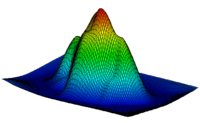GMS:2D Grid Module: Difference between revisions
From XMS Wiki
Jump to navigationJump to search
No edit summary |
|||
| Line 26: | Line 26: | ||
{{Navbox GMS}} | {{Navbox GMS}} | ||
[[Category:2D Grid]] | [[Category:2D Grid]] | ||
No edit summary |
|||
| Line 26: | Line 26: | ||
{{Navbox GMS}} | {{Navbox GMS}} | ||
[[Category:2D Grid]] | [[Category:2D Grid]] | ||
| 2D Grid Module | |
|---|---|
 | |
| 2D Grid | |
| Creating and Editing 2D Grids | |
| Converting 2D Grids | |
| More | |
| 2D Grid Display Options | |
| 2D Grid Tool Palette | |
| Cell Properties | |
| 2D Grid Commands | |
The 2D Grid module is used for creating and editing two-dimensional Cartesian grids. A number of tools are provided for working with 2D grids. Currently, GMS only allows one 2D grid per project.
2D grids are primarily used for surface visualization and contouring. This is accomplished by interpolating to the grid. The figure below is an example of interpolating contaminant concentration data to a 2D grid.
Two types of grids are supported in the 2D Grid module: mesh-centered grids and cell-centered grids. With a mesh-centered grid, the data values are stored at the corners of the grid cells. With a cell-centered grid, data values are stored at the cell centers.
When a dataset is imported to a cell-centered grid, there is one value in the dataset for each cell. The contouring and fringing functions use scalar values at the cell corners. Therefore, whenever contouring or fringing is performed, the values at the cell centers are interpolated to the cell corners. Interpolation to cell corners is only done for visualization purposes. All computations performed using the data calculator are performed on the original values at the cell centers. With mesh-centered grids, all visualization and computations are performed at the cell corners and no interpolation is necessary.
Grids in GMS are Cartesian grids. That is, the row and column spacing in the grid can vary, but the row and column boundaries are straight. Each cell center or grid node can have a unique elevation. The grid can also be rotated about the Z axis if desired.
| [hide]GMS – Groundwater Modeling System | ||
|---|---|---|
| Modules: | 2D Grid • 2D Mesh • 2D Scatter Point • 3D Grid • 3D Mesh • 3D Scatter Point • Boreholes • GIS • Map • Solid • TINs • UGrids | |
| Models: | FEFLOW • FEMWATER • HydroGeoSphere • MODAEM • MODFLOW • MODPATH • mod-PATH3DU • MT3DMS • MT3D-USGS • PEST • PHT3D • RT3D • SEAM3D • SEAWAT • SEEP2D • T-PROGS • ZONEBUDGET | |
| Aquaveo | ||